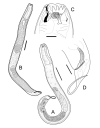|
 |
Females:
- Didelphic, amphidelphic, ovary branches reflexed.
- Vagina straight, without cuticularizations, surrounded by single
sphincter muscle.
- Vulva at 50% of body length
- Anus and rectum absent.
|
|
Halichoanolaimus brandtae A: Male; B: Female; C: Head with
spiral amphid, enticles, mandibles; D: Male tail.
Scale bars: A-B = 150 um; C = 25 um; D = 50 um
Drawings from Zograf et al., 2015 |
|
|
Males: |
|
- Diorchic,
- Five precloacal supplements,
- Spicules paired, arcuate, 1.9 cbd long.
- Gubernaculum without apophyses, 1.1 c.b.d. long.
- Tail anterior conoid (25%) and posterior cylindrical
(75%) parts' 4.7 cbd long; a few somatic setae on the cylindrical part.
Reported median body size for this species (Length mm; width micrometers; weight micrograms) - Click:
|
|
Predatory marine nematodes. Recorded from bottom sediments between 200
and 500m deep off the coast of Sweden.
Predatory: intestinal contents observed include undigested remains
(spicules and gubernacula) or partially digested entire bodies of a variety of
nematode species,
Spicules of ingested nematode prey sometimes fround in posterior of blind
intestine (Zograf et al., 2015).
Zograf, J., Trebukhova, Y., Pavlyuk, O. 2015. New deep-sea
free-living marine nematodes from the Sea of Japan: the genera Siphonolaimus
and Halichoanolaimus (Nematoda: Chromadorea) with keys to species
identifications. Zootaxa 3911 (1) 63-80